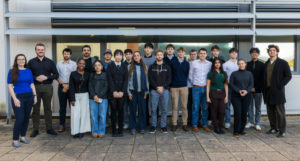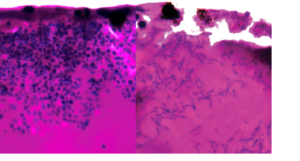New insights into how ocean algae handle a lack of nitrogen and phosphorus

The model diatom Phaeodactylum tricornutum expressing a fluorescent reporter
Scientists at the University of Exeter and the Marine Biological Association (MBA) have discovered how tiny photosynthetic microbes known as phytoplankton prioritise resource use when nutrients are scarce, in a breakthrough that could reshape our understanding of the impacts of nutrient limitation on these important organisms, which form the base of marine food webs.
Phytoplankton such as diatoms are the ocean’s “first responders” to environmental change. These microscopic algae act as a vast natural sink for carbon dioxide and can form massive algal blooms. Their growth, however, depends on the availability of the key nutrients nitrogen and phosphorus.
Until now, scientists have typically studied the effects of these nutrients one at a time. But in reality, phytoplankton are often limited by multiple nutrients at once in the environment. The new study, published in Science Advances, reveals what happens to diatoms when both nitrogen and phosphorus are in short supply.
Dr Katherine Helliwell, Research Fellow at the University of Exeter and MBA, said: “Using advanced molecular approaches, we have shown that when experiencing co-limitation by nitrogen and phosphorus, diatoms prioritise acquiring nitrogen, while effectively switching off their ability to sense and take up phosphorus. Moreover, despite experiencing severe nutrient stress, co-limited diatoms have an exquisite ability to rapidly recover when nutrient levels improve. This could contribute to their success as major bloom-forming algae”
This nutrient ‘co-limitation’ response has wide-reaching implications. If phytoplankton “turn off” their phosphorus machinery, it could make it harder for scientists to monitor phosphorus stress in the ocean where nitrogen is also limited. Since nutrient levels are already shifting due to climate change and pollutants from farming, sewage and industry, understanding these responses is vital.
The study highlights how much remains unknown about phytoplankton biology. Far from being simple organisms, diatoms fine-tune and coordinate processes to maximise resource use and survive under challenging conditions when nutrients are scarce. To use phytoplankton effectively as indicators, scientists need a deeper understanding of the biology behind how they sense, prioritise, and take up nutrients.
The discovery also raises big questions about how widespread this strategy is among different phytoplankton species, and how it might play out in other phytoplankton populations.
Dr Helliwell said: “Phytoplankton are arguably the most important organisms in the oceans. Yet, key aspects of their biology remain unknown and so the potential for discovery is very high. This paper gives us a deeper understanding of what controls phytoplankton growth and physiology, and in doing so could improve our ability to quantify the consequences of climate change and changing nutrient patterns on natural phytoplankton populations.”
The paper is published in Science Advances and entitled “Nitrogen status exerts dynamic control over phosphorus sensing and acquisition via PSR1 in co-limited marine diatoms“



